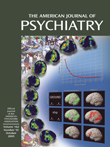Closing in on Schizophrenia
This issue of the Journal features three articles on the neurobiology of schizophrenia that converge from complementary angles toward a coherent method for identifying the neural mechanisms that underlie the heterogeneous clinical presentation of the disorder. Fanous et al. examined whether a high-risk haplotype in the dysbindin (DTNBP1) gene was overtransmitted to individuals who have a high level of clinical manifestation of five factors derived from the Operational Criteria Checklist for Psychiatric Illness. They found that participants in the Irish Study of High-Density Schizophrenia Families who scored high on the negative symptoms factor inherited the high-risk haplotype with a higher frequency than would be expected by chance. The analysis was motivated by earlier findings of association between dysbindin and schizophrenia and a report of reduced expression in dysbindin in the prefrontal cortex and in presynaptic hippocampal sites in postmortem tissue. By showing the specificity of the effect to negative symptoms, the authors have opened a bridge to a mechanistic understanding of the neural systems that produce negative symptoms and their associated cognitive deficits.
Two functional imaging studies in this issue give us a glimpse of what awaits on the other side of the bridge. In a study of first-episode patients with schizophrenia, Tan et al. performed functional magnetic resonance imaging (fMRI) to examine the maintenance and manipulation components of working memory. They targeted working memory because of its well-established link to the dorsolateral prefrontal cortex, where there is well-documented dysfunction in schizophrenia. They reported that patients were specifically impaired in manipulation of information rather than in maintenance of information and that they had reduced dorsolateral prefrontal cortex activation, consistent with previous studies. However, they also found a reciprocal increase in activation in the ventrolateral prefrontal cortex, an indication of compensatory processes. Going beyond a demonstration that certain brain regions show abnormal activation in schizophrenia, such findings begin to separate effects on specific processes and identify areas where compensatory efforts are already in place. The presence of these effects in first-episode patients is consistent with the possibility that such abnormalities in brain activation are reliable traits that could serve as endophenotypic markers for genetic studies. Reciprocally, the genetic findings of Fanous et al. encourage targeted imaging studies to further elucidate frontal brain systems that are dysfunctional in schizophrenia.
Dysbindin is expressed not only in the frontal lobe, and hippocampal abnormalities have also been reported in schizophrenia. The study by Ragland et al. focuses on the intersection between the temporolimbic and frontal systems involved in episodic memory processing. The authors used event-related fMRI to measure activation during shallow and deep word encoding and recognition in patients with schizophrenia and healthy comparison subjects. The patients showed normal levels-of-processing effects, with faster and more accurate recognition of deeply processed words. These effects were accompanied by left ventrolateral prefrontal activation during encoding in both groups, but the thalamus, hippocampus, and lingual gyrus were overactivated in the patients. During recognition, however, the patients overactivated the left frontal pole and underactivated the right prefrontal region. These findings complement those of Tan et al. in showing that both deactivation and overactivation characterize abnormal brain function in schizophrenia. The good news is that patients can form and maintain semantic representations when provided with organizational cues and that such efforts at “remediation” improve encoding and retrieval. This kind of study is the first step toward scientifically based interventions in this area.
Together, these studies illustrate the scaffoldings for construction of new paradigms that exploit advances in molecular biology and neuroscience toward elucidation of the mechanisms in the phenomenology of schizophrenia. Genetic studies are moving beyond investigating linkage to the dichotomous presence or absence of illness and are now showing unique relations between haplotypes and specific clinical manifestations. Neuroimaging studies have gone beyond showing failure of activation in patients with schizophrenia and are now examining mechanistically the interplay between failure to activate and compensatory processes. The studies by Fanous et al., Tan et al., and Ragland et al. in this issue all have as their aim the examination of frontotemporal and memory organization, which seems to emerge as a dysfunctional system related to the severity of negative symptoms. In contrast to the earlier emphasis on positive symptoms and the dopaminergic system, dysbindin and memory are linked to glutamatergic neurotransmission abnormalities that have increasingly become the target for therapeutics. The two frontiers of genetics and neurobiology are thus closing in on schizophrenia, ready to parcellate the rich and heterogeneous presentation of this disorder into its component systems with their underlying neurobiology.
Address correspondence and reprint requests to Dr. Gur, Department of Psychiatry, University of Pennsylvania, 10 Gates Bldg., 3600 Spruce St., Philadelphia, PA 19104-4283; [email protected] (e-mail).



